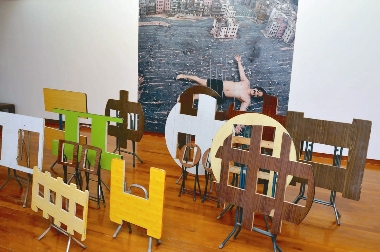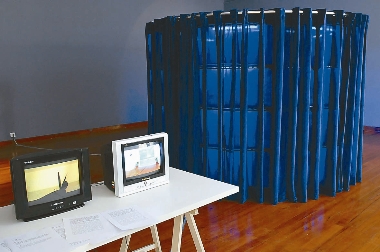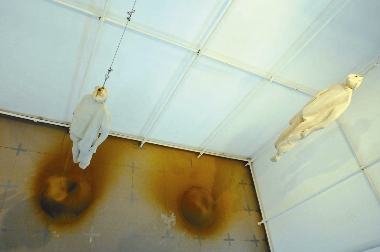|



Newman Huo
THE artistic duo, Pakeong from Macao and Wu Jian’an from Beijing, put together 30 pictures they created and titled them “Non-attack.”
In it, 30 pictures are arranged in an order which reveals a relationship in which every piece is overcome by the one that immediately follows.
The first picture by the Macao artist is a tri-colored glazed camel from the Tang Dynasty, which represents the booming commercial civilization of ancient China, and the second by the Beijing artist is Aladdin’s Lamp, which overcomes the image of the camel of the Tang Dynasty since it represents the precious goods from Turkistan, an important trade partner of the Tang empire.
The two artists believe that the wit of the design of their pictures lie in the fact that there is no ultimate winner as all things are in a relationship of check and balance, in which they are bound to experience both victory and defeat.
Born to a Chinese father and Portuguese mother in Macao in 1978, Pakeong graduated from the Arts School of Macao Polytechnic Institute. He is now working as a freelance graphic designer, illustrator, photographer and a vocalist of Blademark, a pop music band in Macao.
Born in Shanghai in 1980, Wu now lives and works in Beijing. He received his master’s degree from the prestigious Central Academy of Fine Arts (CAFA) in Beijing in 2005 and was immediately recruited to help establish the college’s experimental art department upon graduation.
As a creative artist, he works continuously to create new ways of bringing a contemporary, radical aesthetic to the largely moribund Chinese folk art tradition.
The duo’s work is now being displayed at the “1+1: A Cross-Strait-Four Region Artistic Exchange Project” exhibition at He Xiangning Art Museum in Nanshan District.
The two individuals are among the 16 artists and designers from the Chinese mainland, Hong Kong, Macao and Taiwan participating in the project.
The 16 artists gathered at He Xiangning Art Museum in October last year to meet each other, and finally made eight pairs to prepare their works for an experimental art exhibition.
According to the project’s chief organizer Feng Boyi, in the process of pairing, artists from Hong Kong, Macao, and Taiwan could easily find a desirable partner while those from the mainland appeared unpunctual and unmotivated.
“We were truly surprised to find that artists from Hong Kong, Macao and Taiwan were more reserved, modest, well-mannered and unassuming whereas Chinese mainland artists were more pompous and egotistical,” said Feng.
The project’s organizers jumped in and attempted to mediate the pairing. Eventually, two artists from the Chinese mainland, Liang Yuanwei from Beijing and Bai Xiaoci from Shenzhen, were put together, even though this match had broken the prescribed principle of putting artists from different places into a pair.
Feng believes the installation, “In-Betweens,” produced collaboratively by Liu Liyun from the mainland and Wong Cheuk-hin from Hong Kong, has achieved the project’s ideal of successful artistic exchange among the four places.
The installation is made up of two humanlike dolls hung in midair with fine sand flowing uninterruptedly out of their bodies and onto the floor.
Born in Inner Mongolia in 1974, Liu obtained a bachelor’s degree from the Central Academy of Fine Arts in Beijing in 1997, and a master’s degree from the Kent Institute of Art and Design in Britain in 2000.
She returned to China and held her first solo exhibition at the Channel Gallery of CAFA in Beijing in 2001.
In 2003, Liu stayed at Fukuoka Asian Art Museum in Japan for three months and was astonished to find that traditional Chinese culture has been well maintained in Japan.
Liu’s recent works have paid more attention to the connection between human beings and nature.
Growing up in Hong Kong and Britain, Wong is a freelance architectural designer, independent stop-motion animator, and a full-time cross-disciplinary creative aberrant.
His works negotiate between fiction and reality, constantly seeking dynamic redefinitions and shifting relationships between architecture, art and design.
According to Feng, unsuccessful collaboration in the project can be seen in the case of Zhao Zhao from Beijing and Tan Kai-ti from Taiwan.
During the October matchmaking session, they thought highly of each other. Tan even traveled from Taipei to Zhao’s studio in Beijing to spend some time communicating face-to-face. The video presented in the exhibition includes scenes of Zhao showing Tan around the Imperial Palace in Beijing.
Then, perhaps because “little common ground exists for those of divergent principles,” their collaboration stopped.
As they were unable to produce a finished collaborative work, their works have to be exhibited separately in the exhibition.
Feng said what most disappointed him was the pairing of Liu Zhizhi, a designer from the Chinese mainland who participated in the exhibition as an artist, and the Hong Kong-based Trilingual Design Group.
“As the exhibition drew near, Liu unilaterally abandoned the collaboration and left us unprepared to deal with the graphic design needs of the exhibition,” Feng said.
“I still don’t know what caused this situation. Perhaps it was the mentality of blundering competitiveness,” he said.
The exhibition is organized jointly by He Xiangning Art Museum, Hong Kong Arts Center and Kuandu Museum of Fine Arts in Taiwan. It will move to Hong Kong and Taipei after it is over May 8.
Dates: Through May 8
Hours: 9 a.m.-5 p.m. Closed Monday
Venue: Guan Shanyue Art Museum (关山月美术馆)
Add: 6026 Hongli Road, Futian District (福田区红荔路6026号)
Metro: Shao Nian Gong Station (Children’s Palace Station, 少年宫站), Exit B
|

